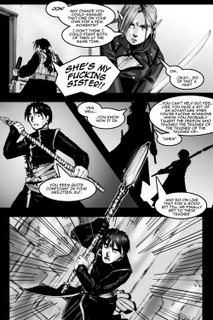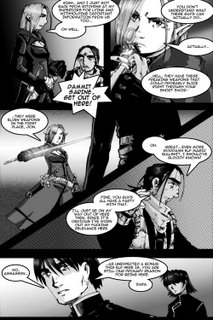
Fantasy has always been a despised genre in the pixelsphere, thankfully it has been influenced by manga which maintains a certain levity where fantasy novels are typically torpid sub-Tolkien travesties (Eddings, Dragonlance, we are looking at you.) I had previously neglected Errant Story because I’d assumed it was a mere continuance of Exploitation Now with its screw ball comedy. It has progressed considerably since I’ve last seen it.
What interests me is the use of the intertwining narratives that adds complexity to the narrative as a whole. This is a strip more than willing to indulge in flashbacks and large chunks of narrated back-story. It surprised me because I’d always though of Poe as a one trick pony with crudely proportioned mangaesque art and stale jokes regurgitated into a pop-culture stew.
However, the subsequent development of Errant story shows me what I’ve been missing, I’ve been going through the archives and what I see impresses me. The mixture of a twenty-first century magicised Tokyo and an outside medieval world denotes a flair for genre-mixing. There are slight cyberpunk/steam punk touches and Poe’s artwork has improved measurably into a far sleeker and more mature mangaesque style.
 The inter-species warfare and religious intolerance evident in the backbone of the story bares everything else along with it. If half-elves are supposedly insane then the rest of this fantasy world doesn’t look any saner. Here, Poe is tackling the interactions between technology and faith as well as nature versus nurture. Meji’s adventure started off as something specious but the story has progressed into something more mature as parts of it have been slowly fleshed out.
The inter-species warfare and religious intolerance evident in the backbone of the story bares everything else along with it. If half-elves are supposedly insane then the rest of this fantasy world doesn’t look any saner. Here, Poe is tackling the interactions between technology and faith as well as nature versus nurture. Meji’s adventure started off as something specious but the story has progressed into something more mature as parts of it have been slowly fleshed out.
Of course the mixture doesn’t always come off, there are moments in which Poe is unable to contain either pathos or badly paced humour, these moments have been getting rarer though and the strip has meshed these disparate forces together, becoming far more serious in its intent. The strip is aiming at a serious examination of what it is to be human and that’s probably it has been mostly neglected by an audience needlessly happy with ‘slice of life’ and fantasy in-jokes.

 The inter-species warfare and religious intolerance evident in the backbone of the story bares everything else along with it. If half-elves are supposedly insane then the rest of this fantasy world doesn’t look any saner. Here, Poe is tackling the interactions between technology and faith as well as nature versus nurture. Meji’s adventure started off as something specious but the story has progressed into something more mature as parts of it have been slowly fleshed out.
The inter-species warfare and religious intolerance evident in the backbone of the story bares everything else along with it. If half-elves are supposedly insane then the rest of this fantasy world doesn’t look any saner. Here, Poe is tackling the interactions between technology and faith as well as nature versus nurture. Meji’s adventure started off as something specious but the story has progressed into something more mature as parts of it have been slowly fleshed out. 




